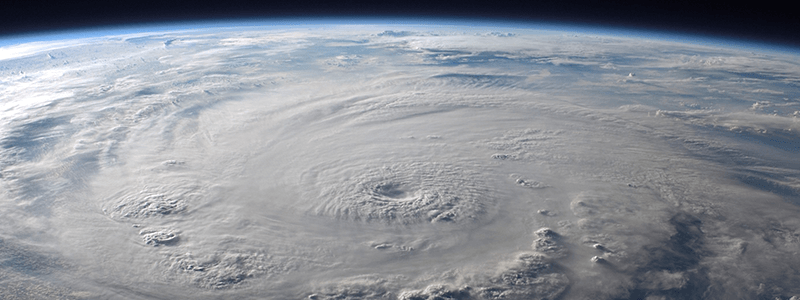

What is a hurricane?
Hurricanes, typhoons, and cyclones
The different terms hurricanes, typhoons and tropical cyclones all refer to tropical storms. They are named differently depending on the region they occur in. In the North Atlantic and Northeast Pacific oceans, they are called hurricanes, whereas they are known as typhoons in the Northwest Pacific. Tropical storms are referred to as cyclones in the South Pacific and the Indian Ocean.
What is a hurricane?
A hurricane is a storm system rotating around an area of low pressure, which produces strong winds and heavy rain. Technically the system is called a tropical storm if wind speeds are between 34 and 63 knots, and it is only classified as a hurricane if the wind speed exceeds 63 knots. A hurricane is on average 500 miles wide and 10 miles high and moves forward like an enormous spinning top at a typical speed of 17 knots.
How do hurricanes form?
The following five factors are generally required for a hurricane to develop:
- Sea surface temperatures of at least 26.5°C are needed down to a depth of at least 50m causing the overlying atmosphere to be unstable enough to sustain convection and thunderstorms
- Rapid cooling with height allows the release of the heat of condensation that powers the hurricane
- High humidity, especially in the lower-to-mid troposphere, provides the moisture that feeds the storm
- Low amounts of wind shear as high shear is disruptive to the storm's circulation
- Hurricanes form more than 5 degrees of latitude away from the equator allowing the Coriolis effect to deflect winds blowing towards the low-pressure centre and creating a circulation.
At the centre of the hurricane is an area of sinking air called the eye of the storm or inner core. Weather in the eye is normally calm and cloud-free. The eye is circular and can range from 2 to 230miles in diameter.
North Atlantic Hurricane season
The North Atlantic hurricane season officially starts on 1st June and runs until the end of November, peaking sharply from late August and throughout September. On average, there are 8 to 10 hurricanes in the Atlantic Basin per year.
How are hurricanes named?
Storms that reach tropical storm strength are named to provide a unique identifier when issuing forecasts and warnings.
North Atlantic storms are named by the US National Hurricane Center (NHC). There have been six lists of names in use since 1979. The lists are in alphabetical order and alternate between male and female. The lists are recycled after six years, although the names of notable hurricanes are retired by the NHC on request. All letters of the alphabet are used except Q, U, X, Y, and Z, and if the names on a list are all used, storms are then named after the letters of the Greek alphabet (Alpha, Beta …).
The 2005 season was the most active season in recorded history, with 28 storms. It was the first season to use "V" and "W" names, and when the season ran out of official alphabetical names after the use of Wilma, forecasters resorted to using letters from the Greek alphabet for the first time.
Does climate change influence hurricanes?
There has been a lot of media discussion about whether or not climate change might have contributed to the severity of Hurricane Harvey, Hurricane Irma, and Hurricane Maria in 2017. Hurricanes are extremely chaotic, dynamic, and occur very localised, which makes it hard to detect climate change signals in these climate system features. Despite over 100 years of Hurricane records in the Atlantic Basin, it has not been possible to detect robust long-term trends in the frequency or strength of Hurricanes.
Nevertheless, observations show a rise in global ocean water temperatures, including in the Gulf of Mexico, as a result of anthropogenic climate change. It is also known that precipitation rises in a warmer atmosphere. These two factors are anticipated to increase the intensity and rainfall of tropical storms when they form. When tropical storms make landfall, severe flooding occurs in many cases. Extensive urban development resulting in paved concrete semi-impermeable surfaces let rainwater not drain away easily. Instead, it might lead to exacerbated flooding. There are also indications in the scientific literature for stationary behaviour of extreme events. This was the case with Hurricane Harvey, which remained above Texas after making landfall.
The severity of flooding after storm surges is also likely to be influenced by sea-level rise. Over the past 100 years, global sea levels have risen almost 20 cm due to the expansion of warming ocean water and the melting of land-based ice into the seas. Effects of sea-level rise, partly induced by climate change, might be more severe regionally.
Teaching about Hurricanes and Tropical Cyclones
The Royal Meteorological Society has developed a set of Tropical Cyclone teaching resources for 11-14 year olds which can be found on our education website, MetLink.


